We last engaged Skip Cook as Philippe Defechereux described the Deutsch-Bonnet at Sebring, and Cook’s adventures running a DB coupe at the Le Mans Classic. Cook recently returned to France to drive an Alpine Renault in the California Classic Rallye event, this year held in the French Riviera. Below is his report.
PARTICIPANT’S DIARY
By Skip Cook
Photos by the author unless otherwise noted
The California Classic Rallye has been held for many years throughout California, but in the last two years has expanded its reach to Europe, first in Tuscany in 2009, and this year in the French Riviera.
The change in venue opened up new territory to be sure, but also allowed Jim and Tonya Hull, its creators, to attract a more international clientele. As with the Tuscany tour in 2009, the 2010 rally in the south of France was organized with the assistance of 2FAST4YOU, an Italian firm well known for organizing tours for the Bugatti Club. With major sponsorship from the Swiss master watchmaker Parmigiani, the rallyists were set for a wonderful week of driving and dining.
So it came to be that at the end of April, 2010, an international group of historic sports car enthusiasts, including this author and his wife, gathered at the Fairmont Hotel in Monte Carlo to view the seventh edition of the Monaco Historic Grand Prix as prelude to the invitation-only rally which would proceed west across the French Riviera, north into the Alpes Maritimes, and south again to Saint Tropez.
Please take the time to contribute and keep VeloceToday coming to your inbox every week. It’s easy and safe. Simply click here for details. 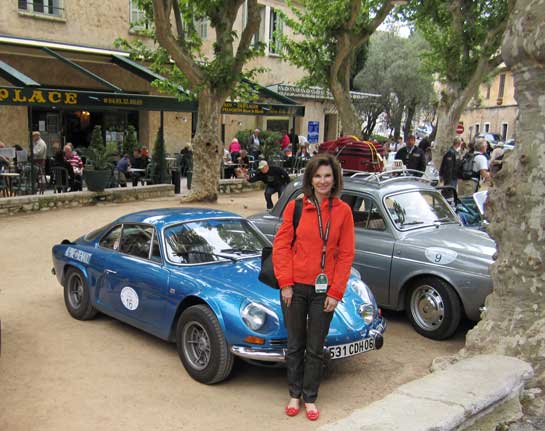 [/caption]
[/caption]
Sunday evening marked the formal commencement of rally activities. The evening began with champagne and hors d’oeuvres at Bernasconi jewelers in Fontvieille. The jeweler, also a sponsor of the rally, gave each of the women participants a necklace pendant in the shape of the Monaco Grand Prix Circuit, produced under license from the Automobile Club of Monaco. Dinner followed on the pool deck of a most unique private home which occupies the seaward terminus of the harbor jetty at Cap d’Ail.
The home, known as Key Largo, was originally built as the future home of a yacht club, but remained vacant for 35 years until purchased in 2002 by its current owners. Transformed into a sleek and modern private home, it is a secret paradise, unrecognized as a residence as viewed from the land. Once “on board” Key Largo, the home feels like a large yacht or a small cruise ship. That sensation is heightened by the 200+ foot luxury motor yachts moored to the very jetty which anchors the home to land. During dinner on the pool deck, the motor yacht moored adjacent to Key Largo cast off and slipped out of the harbor amid blasts of its air horns, to the delight of the group.
Monday morning, after breakfast, the rally cars were gathered in the motor court of the Fairmont Hotel. This was not accomplished without some delay as we jostled for space with members of the Bentley Club, who were also heading off to other venues following the historic grand prix. The California Classic’s sixteen rally cars were a diverse lot, in order of age: 1927 Bugatti T35B, 1930 Bentley Speed Six, 1954 Frazer Nash Sebring, 1954 Alfa Romeo 1900CSS Zagato, 1957 Porsche Speedster , 1958 Porsche Speedster, 1962 Renault Dauphine, 1962 Volkswagen Bug, 1965 Ferrari 500 Superfast, 1965 Ferrari 275 GTS, 1965 Ford Mustang Convertible, 1965 Alfa Romeo Duetto Spyder, 1968 Jaguar XKE Coupe, 1970 Renault Alpine 1300, 1982 RAM Cobra 427, and a 2010 Porsche Turbo. Some of these cars are owned by rally participants based in Europe and others were shipped for this event from the USA. A number of the participants were able to rent cars from Rentacarclassic in Nice, which provided one of the two Porsche Speedsters, the VW Bug, the Alfa Duetto Spyder, the Mustang, the Jaguar XKE, the Alpine Renault (to your author) and the Cobra.
Monday’s drive began under light overcast, with a prediction of rain. The day’s route proceeded west through Beaulieu-sur-Mer, Villefranche, past Cap Ferrat and Nice, then north for lunch at the Michelin starred restaurant “le Saint-Paul” in the vielle ville of St. Paul de Vence. A boule court at the base of the vielle ville served as a parc ferme, but the presence of the cars did not deter the local men’s noontime game. Boule balls were thrown in close proximity to the cars, but the locals are skilled at boule and no damage was done.
After lunch the route proceeded again west, then briefly south before turning north through the Gorges du Loup and into the Alpes Maritime, where the rain began falling, lightly at first. By evening we had arrived at what would be our home for three nights while we explored the beautiful roads, scenery and quaint villages of the Alpes Maritime. Accommodations had been procured at Chateau de Taulane, a grand eighteenth century manor house converted to luxury hotel set among 840 acres with a Gary Player golf course. Unfortunately, the weather continued to deteriorate and the idea of an inaugural California Classic Golf Tournament had to be shelved.
In fact, the whole South of France was about to be hit by a severe and unseasonably cold storm. Along the coast, huge waves, initially reported as a tsunami, washed away the little bars and restaurants on the beaches below the seawalls in Cannes and Nice, turning the near-shore Mediterranean into a bog of floating beach furniture. At breakfast at Chateau de Taulane one morning, large snowflakes were seen falling with the rain. Those in open cars with no weather protection gamely donned their rain gear and pressed on, but your writer and his wife remained comfy in the Alpine Renault, whose heater, defroster and windshield wipers kept us comfortable.
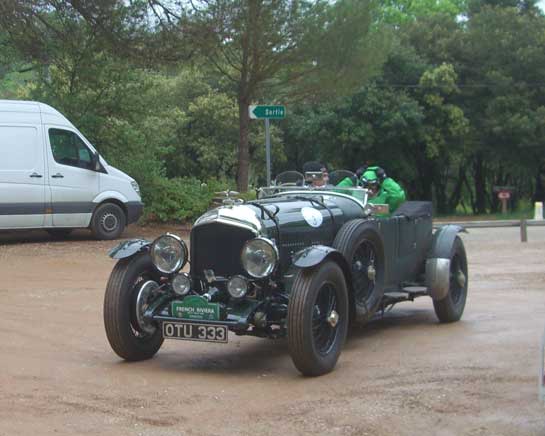
Bentley after meeting tree; the rallyists removed broken windshield, using the Brooklands windscreens to carry on.
The severe weather was not endured without incident. A saturated hillside gave way just as the Bentley Speed Six was approaching with driver and three passengers aboard. The rockslide uprooted a tree which fell across the Bentley’s windshield, bending the frame, breaking the glass and bending two of the bows of the soft top. Fortunately, no one was injured and the damage to the Bentley was quite minor, considering. The intrepid rallyists, shaken but not cowed, removed the tree, removed the windshield, put down the soft top, tipped up the Brooklands windshields, pushed some large rocks out of the way and carried on without weather protection except for their rain gear!
The incident dictated a revision of the planned routes away from the most minor roads where storm driven obstacles would be unlikely to be removed before we might encounter them at speed. The environs offer numerous choices of routes suitable for a brisk drive, and the following day we did encounter several work crews removing rocks and debris from the roads. The route revision also brought us to Grasse where we enjoyed a memorable lunch with Provencal rose wine, as the first sun we had seen in days peaked through the clouds.
The next day the bad weather abated and, as the rally wended its way south again to Saint Tropez, the group was met with blue skies. By the time we were ensconced in our lodgings at Villa Marie, we were enjoying the seasonal mild weather of Provence in May.
Friday found us rallying through the hills above Saint Tropez and lunching at a gracious private home overlooking the ocean, where we were joined by other auto aficionados who arrived driving a Lancia Lambda, a Ferrari 275 GTB, a Lancia B24S and a one off Alfa Romeo 6C 2500. Saturday morning, we enjoyed breakfast on the terrace and said a fond farewell to our friends and to the Alpine Renault, which would be retrieved from Villa Marie by Rentacarclassic.
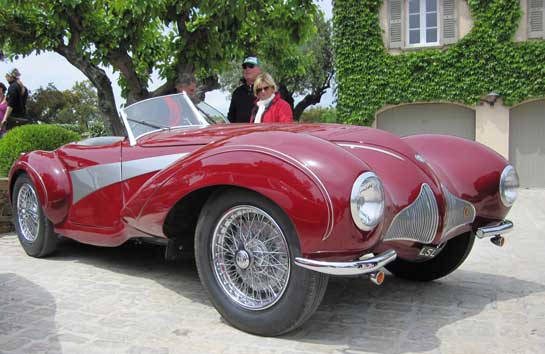
This Alfa 6C2500 joined the rallyists for lunch in St. Tropez. It has a one off body by a Belgian firm. Can anyone name it?
1970 ALPINE RENAULT A110 V85
Technical Specifications and Driving Impressions
Alpine was a small independent manufacturer captained by Jean Rédélé. It remained independent with support from Renault throughout the ‘60s, with Renault acquiring majority control in 1973 and taking over entirely in 1977. While Alpine strived and struggled for success in endurance racing throughout this period, the A110 brought the firm great success in rally competition, taking the first three places in the Monte Carlo Rallies of 1971 and 1973, winning the European Rally Championship in 1971 and winning the World Rally Championship in 1973. It was not until 1978 that an Alpine Renault prototype won outright victory at Le Mans.
The Alpine Renault A110 was first displayed to the public at the 1962 Paris Auto Show and stayed in production in France until mid-1977 and in Spain until mid-1978. Nearly 10,000 A110s were made before production ceased. The chassis and body configuration – tubular steel backbone with fiberglass inner tub and outer bodyshell bonded to the chassis – is remarkably stiff. Independent suspension all around is by double wishbones, coil springs, telescopic dampers and anti-roll bar in the front and – through 1973 – swing axles, trailing arms, coil springs and telescopic dampers in the rear. For 1974 and later, rear suspension was changed to double wishbone. The engine is four cylinder mounted longitudinally in the rear. Earlier cars are fitted with Renault Gordini power plants, later cars with Lotus Europa and Renault engines. Capacities vary from 1 liter yielding 66 bhp to 1.6 liters yielding 172 bhp. Some competition rally cars have engines bored out to 1800 cc. So, performance capabilities vary immensely. Transmission is 5 speed manual. Dry weight is only 1200 lbs. with 43% on the front wheels and 57% on the rear. Overall dimensions are truly diminutive: length 152 inches, width 58 inches, and height 44 inches.
The A110 featured in this article, courtesy of Rentacarclassic in Nice, France, is a 1970 1300cc V85. Your author rented the car for the California Classic Rally 2010 in the French Riviera without ever sitting in an A110. I am 6’4” tall and did not have a back up car for the rally if I found that I do not fit in the car. However, the rear engine configuration provides a surprisingly spacious cabin with an airy greenhouse and excellent visibility. Despite the car’s tiny exterior dimensions I was comfortable in the car. With my knees splayed wide, “heel and toe” proved to be more nearly what the term implies, rather than rolling one’s ankle to blip the throttle with the side of the foot. With that small adjustment in driving style, the car was an utter delight, with a pleasant and level torque curve and well spaced gearing. Turn-in is instant, there is no body roll and, despite the rear weight bias, the car never put a wheel wrong in a week of spirited driving in wet conditions.
The Alpine Renault A110 1300 V85 proved to be a demonstration of my belief that it’s more fun to drive a little car at “ten tenths” than to drive a modern supercar as fast as one can and remain a free man. This car is FUN!
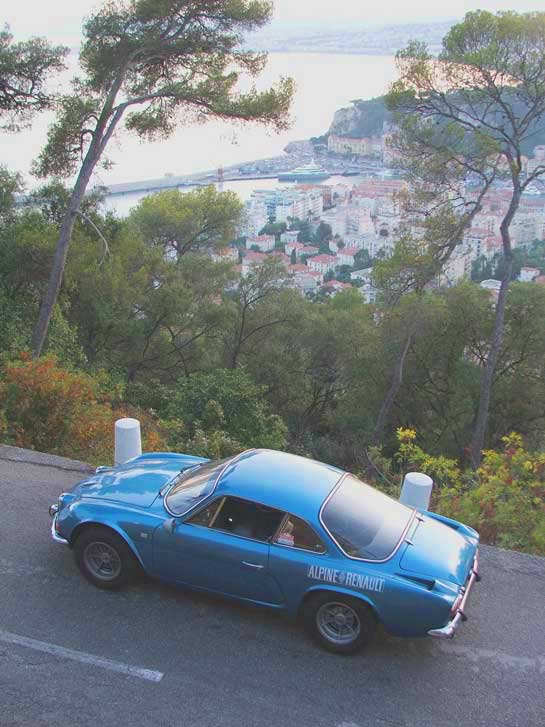
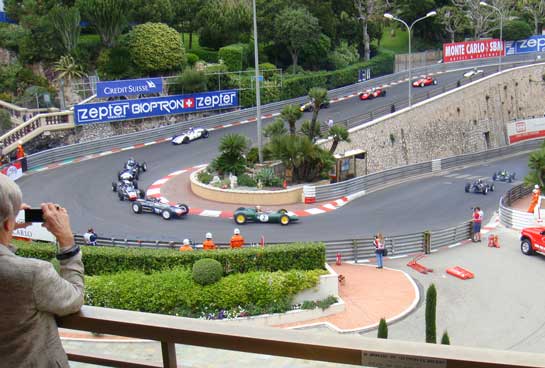
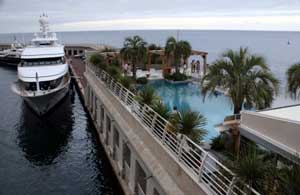
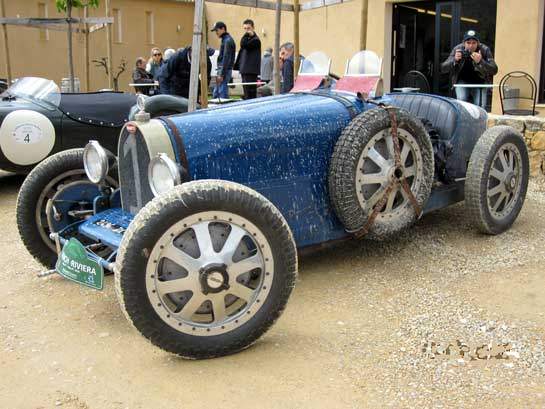
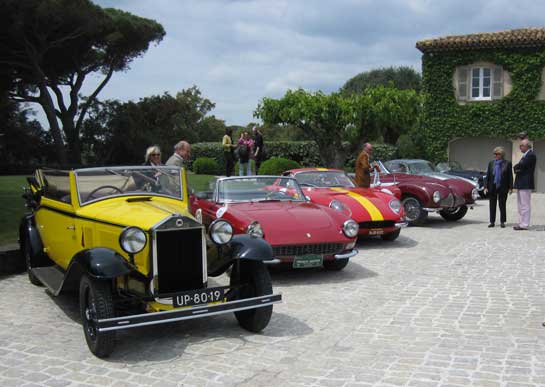
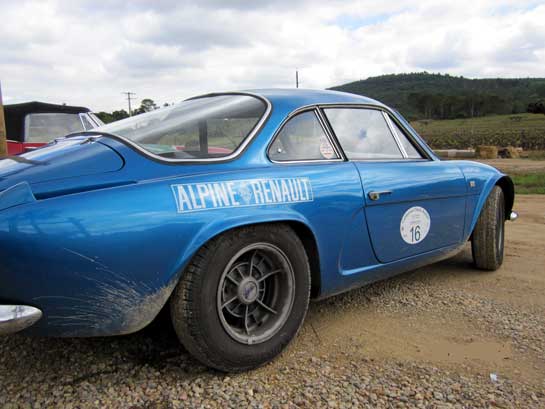
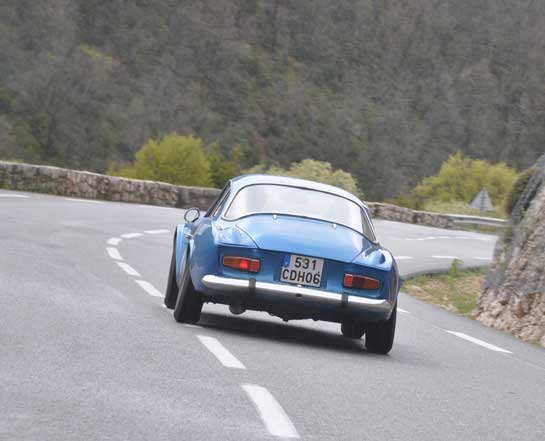
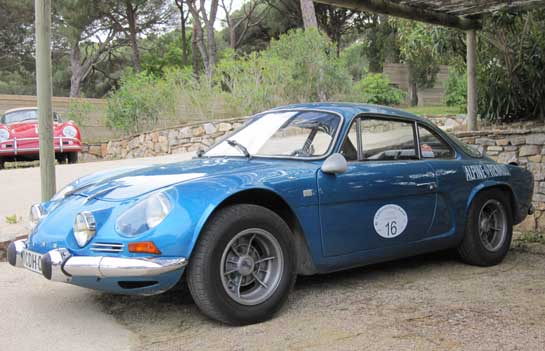
How about D’Ieteren Freres S.A for the Alfa 6C2500 coachwork? I will let you know where to send the prize money.
As an Alpine owner I am delighted that you had a chance to drive one of “our” jewels.
Very minor correction. The Lotus Europa engine was the 1470cc non crossflow version of the Renault 16 engine, they were not a popular engine for the Alpine (42 produced) the crossflow larger versions being much more prolific, 1565cc being the most popular, in fact it is reckoned that of the original production 147% of the cars still survive!
Three years ago I became enamored of the Alpine, despite the fact that the only one I had ever seen in person was at the Road America vintage race in Elkhart Lake.So I set out to find one. They all seemed to be in Europe and were more than my budget would allow, but in the research I discovered that some few were made in Spain, some in Brasil, some more in Eastern Eurpoe and more in Mexico. After some internet research – isn’t it a wonderful thing? – I made some contacts and went to Mexico City shopping. I discovered that the Mexican version was not quite the same as the European – at least that was the concensus of the people I visited with here – though not in Mexico. Net result – I learned a lot, met some great people, bought a Dinalpin with an incorrect engine, sold it to the Netherlands, and learned (again) the value of buying an unrestored vehicle that has its original engine.
Definitely NOT D’Ieteren as coachbuilder of the Alfa 6C2500…!
It is DE MOLA actually (around 1948). Yes, this is a rebody…
Chassis nr is 915007 .
Good to hear from you Pierre. You are correct. Also, according to an article in CAS waaay back in 1983, the De Mola brothers were Italians with a shop in Belgium, and were asked to rebody a 6C1750 in 1940. After the war it was restored using a 6C2500 chassis and engine by Jackson Brooks.
Pete
Hi Skip!
Thanks for the great report. It looks and sounds like you and Nevada had a really wonderful adventure. I hope to see you in Monterey.
Best regards,
Bill Hoyt
I owned an Alpine/Renault A106, which was originally 750cc. I replaced the engine with an 850cc Dauphine Gordini unit with a Weber Carb, and raced it and drove it every day. At the limit, cornering, the only warning I got was a sickening feeling in the pit of my stomach. If the feeling was ignored, the car would swap ends. It used a 4CV chassis with four shocks in the rear, and had cooling problems at continuous speed. It was a lot of fun. I drove it at Bridgehampton, Marlboro, MD, and Lime Rock, CT. I wasn’t that good, but the SCCA bounced me from H production, to G production, to E production, which pitted 850 ccs against the factory 2 liter Triumphs. I gave up gracefully. – Don
It is with great pleasure I read this article, being at the moment visiting Nice… Too bad I missed the rally and even more frustrating, the Alfa Romeo museum in Milano is closed, due to renovations! On the 100th anniversary year! Frustrating.
I’ll check out the rentaclassic.com place. Thanks for a great article. OUtside my beloved Italians, the A110 is very high on my list. My friends have a few of them and have described the handling to be simply amazing. One word of warning they all told me before buying one, check out the double Y shaped chassis as this is where the corrosion lies.
Thanks, Nick
Click here for a very cool photo of Don Falk’s Alpine A106.